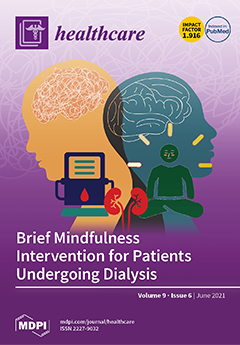The basic way to prevent cerebral stroke in symptomatic 70–99% stenosis of internal carotid artery (ICA) is an open or endovascular surgical procedure. Psychological research done so far among ICA stenosis patients focused on cognitive functioning changes. The objective was to assess attitude to surgery in relation to self-efficacy, life quality perception, and health locus of control in ICA stenosis patients. Materials and Methods: The study involved 53 asymptomatic ICA stenosis patients, aged from 53 to 81. Four scales were applied: Generalized Self-Efficacy Scale (GSES); Satisfaction With Life Scale (SWLS); Multidimensional Health Locus of Control Scale (MHLC); and a simple scale to examine the attitude to surgery, where “−10” stands for the maximally negative attitude, “0”—neutral, and “+10”—maximally positive. The obtained results were put to statistical analysis. Results: It was found that women and men assessed their attitude to the surgery as positive (
M = 7.92;
SD = 3.094), though the men estimated it slightly higher (
M = 8.03;
SD = 3.02) than the women (
M = 7.67;
SD = 3.37). The mean value of self-efficacy was high (
M = 32.53;
SD = 6.231), and slightly higher for the men (
M = 32.79;
SD = 5.576) compared to the women (
M = 31.87;
SD = 7.836). The patients generally tended to manifest the external personal health locus of control (
M = 28.62;
SD = 3.17). The runner-up was internal health locus of control (
M = 26.02;
SD = 3.775), and the next one—external impersonal aspect (chance/luck) (M = 23.57; SD = 4.457). The mean assessment of the patients’ own life quality proved to be above average (
M = 23.60) but varied (
SD = 5.95). The women perceived the quality of their lives as better (
M = 24.33;
SD = 6.422) than the men (
M = 23.32;
SD = 5.818). Very strong positive correlations were found between self-efficacy and life quality assessment (
p < 0.001) and between the internal and external personal aspects of health locus of control (
p < 0.007) in the women, and positive correlations were found between the attitude to surgery and internal health locus of control (
p < 0.021) in the men. Conclusions: When breaking the news of a need to have a surgical intervention due to ICA stenosis, the physician should strongly refer to the value of human life and health. The message should arise from external (in the case of women) or internal (in the case of men) motivation to undergo surgery, and enhance the patient’s conviction that the disease should be considered a challenge which must be taken to reverse their unfavorable situation and improve life quality.
Full article






